Why leopards need your help
A long read by Rescue & Care Officer Flo Blackbourn, considers five reasons why leopards need your help today.


Flo Blackbourn, Rescue & Care Officer
At Born Free, every species and every individual animal matters. Like all wild animals, leopards have an intrinsic value and play a vital role in maintaining healthy ecosystems. Aided by supporters Born Free is working to protect leopards in the wild, find humane solutions to conflict with people, rescue captive leopards from lives of suffering and provide lifetime care, and campaign to end leopard exploitation.
So why do leopards need your help?
1. Risk of extinction
Leopards are the smallest of the big cat species – though stronger and bulkier than the cheetah (NB some experts don’t consider cheetahs big cats). Although exact population figures are unknown, scientific studies show leopard populations have plummeted dramatically in recent decades.
Leopards as a species are classed as Vulnerable to extinction by the International Union for Conservation of Nature (IUCN), with two of the nine leopard subspecies classed as Endangered and two as Critically Endangered. One subspecies, the Amur leopard, may actually be the most endangered big cat in the world, with only around 100 individuals left in the wild.
A comprehensive study in 2016 found that many leopard populations are faring far worse than was previously believed, with six the nine subspecies in significant trouble. Worryingly, some of the subspecies have seen recent declines in population of over 90%. Declines in leopard numbers are due to many factors linked to human activity, and include wildlife trade, trophy hunting, loss of prey species, direct conflict with people, and loss and fragmentation of habitat.
2. Diminished distribution
While leopards are still the most widespread big cats in the world, their range around the globe has greatly reduced over the years. Leopards are calculated to have lost up to three quarters of their territory, with up to 10.2 million square miles of their previous range gone. Within this statistic, individual species of leopard differ in how much range they have lost – the Amur, Arabian and North-Chinese leopards have lost up to a shocking 98% of their historic range. In 2016, an average of only 17% of remaining leopard habitat was protected, and some subspecies had even less habitat protected.
Six of the nine subspecies of leopard now exist in less than 5% of their historic range and/or inhabit less than 100,000km², yet ironically it is the other three subspecies which are more highly researched. In some areas where the land remains for leopards to live, prey density is too low for the land to efficiently support any more individuals.
3. Trophy Hunting
Despite leopards requiring and being afforded protections due to the struggling of each subspecies, it is still legal to hunt them in several countries. They can be hunted by baiting an area with food to draw them in to be shot, or even by having them sniffed out by hunting dogs.
Between 2005 and 2014 a shocking 4,500 African leopard carcasses were imported into the U.S. having been trophy hunted, and many more were killed by hunters from other countries. With trophy hunters paying tens of thousands of pounds to kill a leopard, a great deal of funding is generated in the industry by leopard hunting alone. Unfortunately, being one of Africa’s ‘Big Five’ only elevates their appeal as a trophy. Males are especially sought after, so more prime males are killed, breaking down social structures and resulting in loss of genetic variation.
4. Captivity

Leopards don’t only suffer from persecution in the wild. Around the world, hundreds of leopards are exploited through entertainment, forced to perform tricks in circuses, live deprived lives in zoos or are even kept privately as pets.
Since our inception, Born Free has campaigned to end circus exploitation and today over 50 countries have full or partial bans on the use of wild animals in circuses. However, many still allow the outmoded ‘entertainment’ to continue. In Europe there are estimated to be around 350 leopards in zoos, with at least 35 in zoos in the UK. Leopards are often nocturnal or crepuscular (active at dawn or dusk), and a 2020 study found that leopards in zoos can be disturbed by nearby animals and large crowds gathered when they are trying to sleep.
Unnatural, repetitive stereotypic behaviours are also seen in zoo leopards, and each year Born Free receives several reports from concerned members of the public about abnormal captive leopard behaviour.
Such behaviours in leopards include repetitive pacing and circling, obsessive grooming (which can lead to irritated skin and bald patches) and even self-mutilation such as leg-chewing.
Private ownership is also shockingly common. It has been reported, for example, that several hundred leopards have been caught and kept in cages or otherwise poor conditions in India after coming into conflict with people. Leopards are also kept as ‘photo props’ for people to pay to have photos with, and even today some view keeping big cats as a status symbol. Born Free research in 2020 found that at least six leopards were being kept privately in the UK.
Around the world, leopards are kept in small enclosures by individuals or zoos, sometimes lacking outdoor space despite the fact that wild leopards can roam 10 miles or more each day. Lack of policy to deal with ‘problem leopards’ coming into conflict with people is an issue. In some cases, a leopard may be killed just for being seen near to a human settlement.
In Kenya Born Free works with local communities to protect big cats and find humane solutions to conflict with people. We fund reinforced predator-proof enclosures called ‘bomas’ to protect livestock at night from leopards, lions and other predators. These bomas help prevent retaliatory attacks on leopards and lions and help ensure their safe future in the wild.
5. Importance in the ecosystem
Finally, leopards are important members of their ecosystems. When in balance, each ecosystem works because every organism – down to the smallest plant and insect – plays an integral part. The leopard is an apex predator – at the top of the food chain. Apex predators are extremely important, driving selective pressures on prey and affecting their distribution and population sizes.
Through their impact on the species below them in the food chain, leopards can alter how a whole habitat functions. Leopards are therefore considered a keystone species – that is, a species which has a large, disproportionate impact on its environment and holds its ecosystem together. They are extremely important for maintaining their ecosystems’ health. When the population of a predator like the leopard struggles, or is removed from an environment altogether, everything about that ecosystem can change and even break down.
These five important points are just some of the reasons why Born Free works so hard to protect leopards. As well as rescuing leopards from zoos, circuses and private ownership and allowing them to live out their lives in spacious sanctuaries, Born Free also campaigns to end their exploitation and to protect leopards in the wild.
HOW YOU CAN HELP
Adopt a Leopard
Since our inception, Born Free has rescued a dozen leopards from captivity and provided them with sanctuary and expert care for life. You can adopt our Leopard Family – Sami, Mowgli and Zeiss – who live at Born Free’s Big Cat Sanctuary in Shamwari Private Game Reserve, South Africa.
From just £3 a month adopters will receive an exclusive leopard adoption pack and regular updates.
Report captive leopard exploitation
You can also help leopards which are suffering as a result of exploitation or living in inadequate captive conditions around the world by alerting us to their situation via our Raise the Red Flag platform: www.bornfree.org.uk/raise-the-red-flag
References
Clark Howard, B. (2016) Leopards Have Lost Three-Fourths of Their Territory, National Geographic [Online] Available at: https://www.nationalgeographic.com/animals/article/160504-leopard-range-shrinks-endangered-subspecies#:~:text=Big%20Threats,in%20some%20areas%2C%20Jacobson%20says [Accessed 4 Nov 2022]
Conniff, R. (2016) India’s captive leopards: a life sentence behind bars, The Guardian [Online] Available at: https://www.theguardian.com/environment/2016/jun/22/indias-captive-leopards-a-life-sentence-behind-bars [Accessed 8 Nov 2022]
Humane Society (2016) Trophy Hunting by the Numbers, Humane Society International [Online] Available at: https://www.hsi.org/wp-content/uploads/assets/pdfs/report_trophy_hunting_by_the.pdf [Accessed 5 Nov 2022]
Jacobson et al (2016) Leopard (Panthera pardus) status, distribution, and the research efforts across its range, PeerJ, Vol. 4
Sethy U. & Mohapatra, S. B. (2020) Leopards in Captivity: A Study of the Effects of the Zoo Environment on their Behaviour, Journal of Research in Agriculture and Animal Science, Vol. 7, No. 7, pp 36-40
Stein et al (2020) Panthera pardus (amended version of 2019 assessment), The IUCN Red List of Threatened Species 2020. Available at: https://www.iucnredlist.org/species/15954/163991139 [Accessed 7 Nov 2022]
Wibisono et al (2021) Panthera pardus ssp. Melas, The IUCN Red List of Threatened Species 2021. Available at: https://www.iucnredlist.org/species/15962/50660931 [Accessed 7 Nov 2022]
Wildlife Vets International (2020) Saving the Amur Leopard, the World’s Most Endangered Big Cat. Wildife Vets International [Online] Available at: https://www.wildlifevetsinternational.org/projects/reintroduction-of-amur-leopard [Accessed 7 Nov 2022]
Images (c) georgelogan.co.uk; Lauren St John
